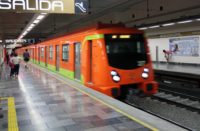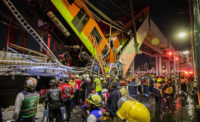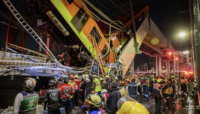Faulty structural welds have been blamed for the deadly May 3 collapse of an elevated section of Mexico City’s Line 12 subway, according to a report issued Sept. 7 by Norwegian risk management firm DNV.
The five-month investigation found numerous instances of structural studs that were poorly welded, improperly located or missing entirely. The DNV report concluded the elevated steel structure and concrete rail bed were acting as “independent parallel beams,” and experiencing “loading conditions for which they were not designed.” That, in turn, led to fatigue cracks in the structure, compromising its weight-bearing capacity.
DNV’s report added that deficiencies in the beams and framework design may also have contributed to the collapse, which occurred as a four-car subway neared a suburban station, sending two rail cars plummeting approximately 16 ft into the median of an underlying boulevard, killing 26 people.
The results confirm DNV’s preliminary findings, which were issued in mid-June. Originally scheduled for release Aug. 23, the latest report was delayed by two weeks at the company’s request so that another group of international experts could conduct “internal reviews” of what DNV called “the most complex phase of the collapse analysis.”
In addition to the DNV investigation, the collapse is also under study by Mexico City’s attorney general and the College of Civil Engineers of Mexico, the country’s civil engineering professional society.
Constructed for $1.3 billion, the 12.6-mile has been steeped in controversy since before it began operation in 2012, with allegations of cost overruns, design flaws and government corruption. An 18-month partial closure in 2014-15 for track and structural repairs sparked an investigation that revealed numerous instances of defective construction materials and questionable project supervision, leading to criminal prosecution of several senior project officials.
Mexico’s president Andrés Manuel López Obrador has stated that Line 12’s elevated sections will reopen by early 2022, with all reconstruction work to be paid for by billionaire Carlos Slim, owner of Carso Infraestructura y Construcción (CICSA), which was part of the subway line’s original construction consortium.
Last month, Mexico City’s advising technical commission recommended that the reconstruction include releveling and realigning the elevated section, and ensuring welding inspections and beam repairs comply with American Welding Society standards. The group also recommended fitting concrete support columns with carbon fiber jackets to increase structural capacity.
Just hours after DNV’s latest report was released, Mexico City was shaken by a magnitude 7.1 earthquake centered approximately 230 miles away near Acapulco. Following a brief shutdown of the city’s subway system all lines were back in operation the following morning.





Post a comment to this article
Report Abusive Comment